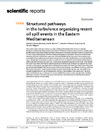Identificador persistente para citar o vincular este elemento:
https://accedacris.ulpgc.es/handle/10553/114133
| Título: | Structured pathways in the turbulence organizing recent oil spill events in the Eastern Mediterranean | Autores/as: | García-Sánchez, Guillermo Mancho, Ana M. González Ramos, Antonio Juan Coca Saenz De Albéniz, Josep Wiggins, Stephen |
Clasificación UNESCO: | 332103 Petróleo crudo 2510 Oceanografía 3308 Ingeniería y tecnología del medio ambiente |
Palabras clave: | Applied mathematics Environmental impact |
Fecha de publicación: | 2022 | Proyectos: | Integrated Marine Pollution Risk assessment AND Emergency management Support Service IN ports AND coastal enVironmEnts N00014-01-1-0769 EP/P021123/1 PIE/202250E001 |
Publicación seriada: | Scientific Reports | Resumen: | The chaotic nature of ocean motion is a major challenge that hinders the discovery of spatio-temporal current routes that govern the transport of material. Certain material, such as oil spills, pose significant environmental threats and these are enhanced by the fact that they evolve in a chaotic sea, in a way which still nowadays is far from being systematically anticipated. Recently such an oil spill event has affected the Mediterranean coast of several Middle Eastern countries. No accidents were reported for these spills previous to their arrival at the coast, and therefore there was no hint of their origin. Modelling such an event, in which uncertainties are increased due to the lack of information on where and when the spills was produced, stretches available technologies to their limits, and requires the use of novel ideas that help to understand the essential features of oil and tar transport by ocean currents. In this regard Lagrangian Coherent Structures enable us to find order within ocean chaos and provide powerful insights into chaotic events and their relationships over different locations and times like the one addressed. Using the observed locations of the oil impacting the coast at specific times, we seek to determine its original location and the time it was released in the open ocean. We have determined both using a combination of earlier satellite observations and computational modelling of the time evolution. The observed agreement between modeled cases and satellite observations highlights the power of these ideas. | URI: | https://accedacris.ulpgc.es/handle/10553/114133 | ISSN: | 2045-2322 | DOI: | 10.1038/s41598-022-07350-w | Fuente: | Scientific Reports [EISSN 2045-2322], v. 12, 3662, (2022) |
| Colección: | Artículos |
Los elementos en ULPGC accedaCRIS están protegidos por derechos de autor con todos los derechos reservados, a menos que se indique lo contrario.
